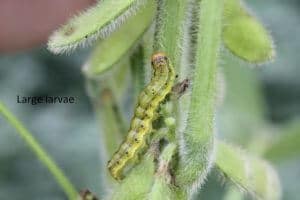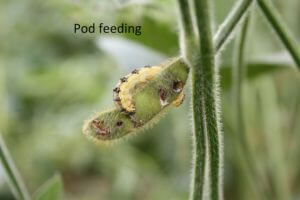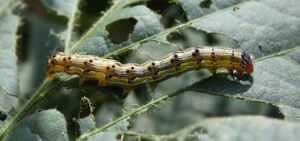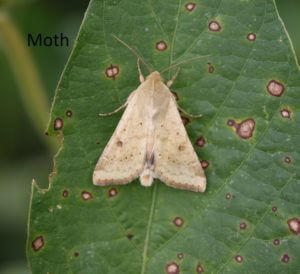Management options
| Insecticide (Trade Names) for CORN EARWORM | Lb Active Ingredient per Acre | Amount Formulation per Acre | Performance Rating |
|---|---|---|---|
| bifenthrin (Brigade 2E, Discipline 2E, Fanfare 2E) * | 0.063 - 0.10 | 4 - 6.4 oz | 6 |
| chlorantraniliprole (Vantacor 5 SC) | 0.047 - 0.067 | 1.2 - 1.71 oz | 9 |
| chlorantraniliprole, bifenthrin (Elevest) | See label | 4.8 - 9.6 oz | 9 |
| chlorantraniliprole, λ-cyhalothrin (Besiege) | See label | 6 - 8 oz | 9 |
| esfenvalerate (Asana XL 0.66E) * | 0.03 - 0.05 | 5.8 - 9.6 oz | 6 |
| indoxacarb (Steward 1.25) | 0.055 - 0.11 | 5.6 - 11.3 oz | 8 |
| methomyl (Lannate LV 2.4) | 0.23 - 0.45 | 12 - 24 oz | 7 |
| NPV virus (Heligen) ** | ---- | 1.0 - 1.6 oz | 6 |
| permethrin (Pounce 3.2E) * | 0.1 - 0.2 | 4 - 8 oz | 5 |
| spinetoram (Radiant SC 1) | 0.031 | 4 oz | 8 |
| spinetoram, methoxyfenozide (Intrepid Edge) | See label | 4 - 6.4 oz | 8 |
| spinosad (Blackhawk 36% WDG) | 0.038 - 0.05 | 1.7 - 2.2 oz | 8 |
| β-cyfluthrin (Baythroid XL 1) * | 0.0125 - 0.022 | 1.6 - 2.8 oz | 6 |
| γ-cyhalothrin (Declare 1.25) * | 0.0098 - 0.0125 | 1 - 1.28 oz | 6 |
| λ-cyhalothrin (Warrior II 2.08) * | 0.015 - 0.025 | 0.96 - 1.6 oz | 6 |
| Z-cypermethrin (Mustang Maxx 0.8E) * | 0.0175 - 0.025 | 2.8 - 4 oz | 6 |
* Corn earworm has developed some level of resistance to pyrethroid insecticides. Thus, they may not provide adequate control. Use another insecticide or tank mix acephate (at least 0.5 lb active ingredient) with a pyrethroid insecticide if infestations are well above the threshold level.
** NPV virus (Heligen) will only control corn earworm. Applications should be made when larvae are small. Do not apply if most larvae are large or if infestations are well above treatment threshold.
- Infestations are far more likely in late maturing soybean. Planting early and planting early-maturing varieties can help avoid infestations that typically occur beginning in August.
- Moths prefer to lay eggs in open canopies, so infestations are often worse in fields with a wide row spacing or when plant populations are low.
- Avoid unnecessary applications of insecticides that may disrupt populations of beneficial insects.





